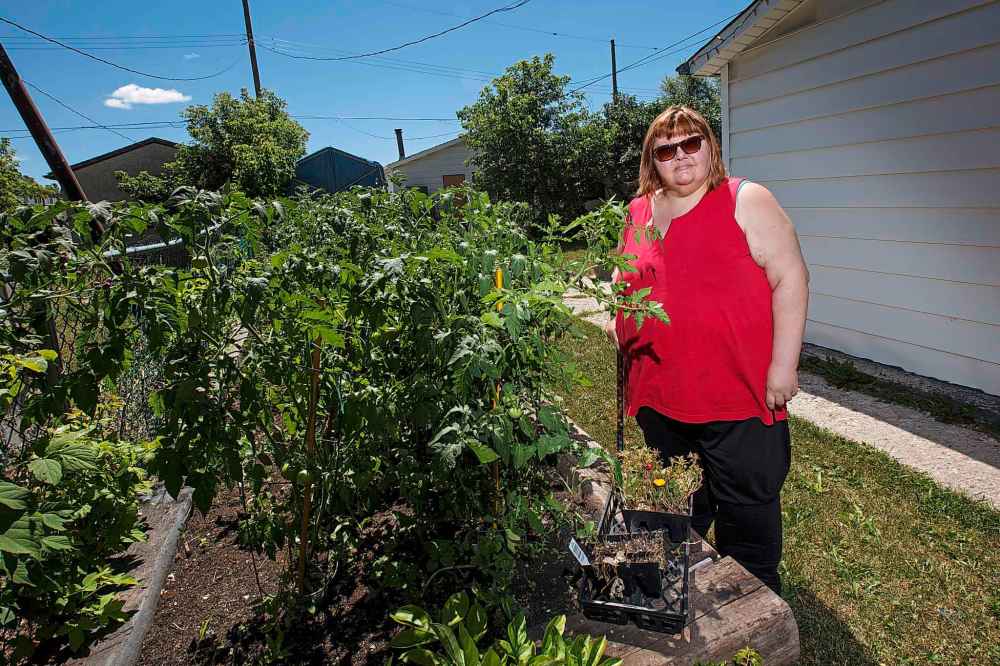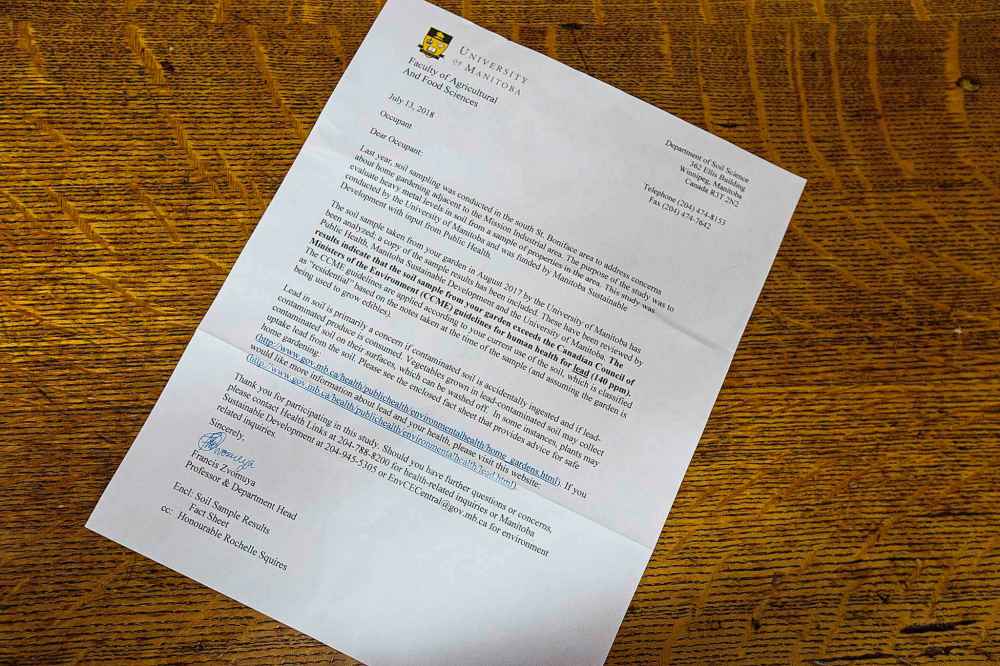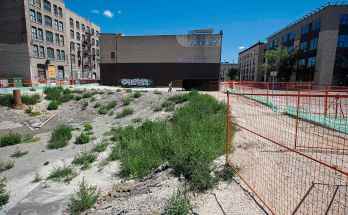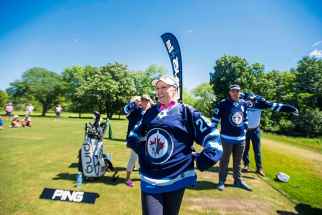Lead in St. B soil samples exceeds safety limits Province cites byelection for silence on 'urgent' issue
Read this article for free:
or
Already have an account? Log in here »
To continue reading, please subscribe:
Monthly Digital Subscription
$0 for the first 4 weeks*
- Enjoy unlimited reading on winnipegfreepress.com
- Read the E-Edition, our digital replica newspaper
- Access News Break, our award-winning app
- Play interactive puzzles
*No charge for 4 weeks then price increases to the regular rate of $19.00 plus GST every four weeks. Offer available to new and qualified returning subscribers only. Cancel any time.
Monthly Digital Subscription
$4.75/week*
- Enjoy unlimited reading on winnipegfreepress.com
- Read the E-Edition, our digital replica newspaper
- Access News Break, our award-winning app
- Play interactive puzzles
*Billed as $19 plus GST every four weeks. Cancel any time.
To continue reading, please subscribe:
Add Free Press access to your Brandon Sun subscription for only an additional
$1 for the first 4 weeks*
*Your next subscription payment will increase by $1.00 and you will be charged $16.99 plus GST for four weeks. After four weeks, your payment will increase to $23.99 plus GST every four weeks.
Read unlimited articles for free today:
or
Already have an account? Log in here »
Hey there, time traveller!
This article was published 17/07/2018 (2702 days ago), so information in it may no longer be current.
Soil samples from at least 24 properties in South St. Boniface’s Dufresne neighbourhood contain amounts of heavy metals — including lead — well beyond acceptable levels, a comprehensive analysis of yards and gardens in the area has shown.
University of Manitoba scientists found that of 150 properties analyzed, 16 per cent of all samples exceeded the Canadian Council for the Ministers for Environment soil-quality guidelines. Dr. Francis Zvomuya, the study’s lead scientist, says the most concerning result was that 18 properties had levels of lead higher than 140 milligrams per kilogram of soil, the maximum amount considered safe.
On Cherrier Street, Gary Tessier’s soil reached as high as 222 milligrams of lead per kilogram of soil. On Kavanagh Street, Paul Demarcke’s property was found to have 169. Zvomuya said those figures aren’t terribly high, but they’re still concerning.

“Anything above 140 isn’t good,” he said. “Once that’s exceeded, it means there’s a risk, and you must exercise precaution.”
Zvomuya recommends thoroughly washing and peeling produce, as well as adding new soil into old plots to dilute possible contaminants. “I think there’s some panic out there, but you can still eat your vegetables,” he said.
Scientists can’t yet determine the origin of the lead, but Zvomuya estimates it could stem from old paints or leaded gasoline deposits in the heavily industrialized neighbourhood.
Last summer, residents grew concerned when soil from locations near the Mission Industrial Park, taken by Zvomuya, showed high levels of metals such as zinc, copper and lead. Many feared whether they’d be able to eat their produce, but provincial representatives assured them there was nothing to worry about.
“All the soil samples taken in the residential and recreational areas showed no reason for concern,” provincial sustainable development minister Rochelle Squires said in an October news conference.
Zvomuya quickly issued a correction saying the data set was too small to provide any valid conclusions for residents. Then, the provincial government began funding the most recent soil study, which drew multiple samples from 150 properties.
But for Darlene Thurston, 52, who has lived in the neighbourhood her whole life, the initial announcement signalled an all-clear, so she grew a garden at the home she shares with her 85-year-old father. After receiving results from the tested samples from her property that showed heightened levels of lead, Thurston was frustrated and confused.
“I planted another garden because I was told it was safe,” she said. “If I would’ve known, I wouldn’t have put all the time and effort into putting in my own garden.”
Thurston figured the soil pollution would’ve been a key factor in Tuesday’s St. Boniface byelection, but said when campaigners came to her door, most had no clue the issue existed.
A spokeswoman for the South St. Boniface Residents Association said they met with all candidates throughout the campaign, and each said it was an important issue to address. “We hope whoever gets elected keeps it in mind,” she said.
Adding to the soil study confusion was the byelection news blackout, which restricted communication from the provincial government and delayed a formal alert to the public, despite the inherent public safety interest involved.
Squires told the Free Press Tuesday she’d known of the results for more than a week before residents were told, but wasn’t able to discuss them publicly. “It gave me great discomfort that I wasn’t able to go public the minute I found out about this and wasn’t able to hold a press conference and have full disclosure,” she said. She called the high levels of metals an “urgent” issue.

The provincial government decided to not release any information regarding the soil study due to a legal opinion from the Crown’s counsel, a government spokeswoman said.
Squires: ‘We sought a variety of opinions to ensure we were not in violation of the blackout’
Manitoba’s sustainable development minister has known about high lead and zinc levels in the soils of two dozen south St. Boniface properties for two weeks, but has yet to issue a formal alert to the public.
In an interview Tuesday, Rochelle Squires said the Progressive Conservative government was prevented from publicizing the findings of a University of Manitoba soil analysis because of a government news blackout due to the St. Boniface byelection.
Manitoba’s sustainable development minister has known about high lead and zinc levels in the soils of two dozen south St. Boniface properties for two weeks, but has yet to issue a formal alert to the public.
In an interview Tuesday, Rochelle Squires said the Progressive Conservative government was prevented from publicizing the findings of a University of Manitoba soil analysis because of a government news blackout due to the St. Boniface byelection.
Squires said affected homeowners were handed letters July 13 informing them of the test results. She told the Free Press she first learned of the results between a week and 10 days before that date.
She said her immediate reaction was to alert all homeowners immediately, and issue a news release, but said there were “some challenges” in doing so due to the byelection, which is being held in that community. (Residents go to the polls today, Tuesday, July 17.)
“Personally speaking, I can tell you that it gave me great discomfort that I wasn’t able to go public the minute I found out about this and wasn’t able to hold a press conference and have full disclosure,” Squires said, noting she had promised a transparent process to the South St. Boniface Residents Association.
The election blackout has been a contentious issue in this byelection, with government departments appearing uncertain what information they can or cannot release to the public. Last week, the media were told they could not photograph the premier posing with Order of Manitoba recipients, despite the fact the award presentation was a non-partisan event.
Section 92 of the Elections Financing Act permits exceptions to the ban on government promotion of its programs or activities if they pertain to “important matters of public health or safety.”
Squires acknowledged Tuesday information about high levels of metals in city soils was an “urgent” issue.
She would not specify exactly who within government advised the general public not be alerted to the soil contamination, including whether government lawyers had opposed the release of the information.
“We sought a variety of opinions to ensure we were not in violation of the blackout,” she said.
A spokeswoman for Squires later clarified that “a legal opinion from Crown counsel” was the “deciding factor” in the government’s decision to withhold the information from the general public.
She said while she could not publicize the results of the soil sampling due to the blackout, she was able to answer media questions about the University of Manitoba’s work.
St. Boniface Coun. Matt Allard was “extremely concerned” about the results, saying he’d thought previous analysis had shown contamination only on industrial sites. He said he’ll be meeting as soon as possible with Don Labossiere, the province’s director of environmental compliance and enforcement, to address the matter.
Residents plan to meet with Zvomuya soon to ask additional questions, the residents association spokeswoman said. But until then, she said, “we are as perplexed as everybody” as to the impact of the metals or how the government is planning to address the situation.
For now, Thurston remains frustrated, and hopes her vegetables are safe to eat as Zvomuya advises.
“(Last year), we were told everything was OK,” she said. “Nobody seems to have a clue what’s going on.”
ben.waldman@freepress.mb.ca
Twitter: @benjwaldman

Ben Waldman covers a little bit of everything for the Free Press.
Our newsroom depends on a growing audience of readers to power our journalism. If you are not a paid reader, please consider becoming a subscriber.
Our newsroom depends on its audience of readers to power our journalism. Thank you for your support.














